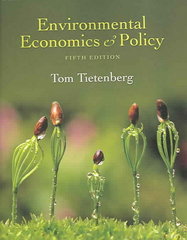Question
Question #1: Consider a small firm, Fresh Farm Produce, that operates in a perfectly competitive market. The market price for organic carrots is set by
Question #1:
Consider a small firm, "Fresh Farm Produce," that operates in a perfectly competitive
market. The market price for organic carrots is set by the market and is currently $2.50 per pound. Fresh Farm Produce can sell as much as it wants at this market price. (Note, while you dont need to do any numerical calculations to answer this question, you may find it helpful to draw a graph!)
A. Explain why Fresh Farm Produce is considered a "price taker" in this market.
B. Explain what actions the firm should take to maximize profits under these market conditions.
C. Describe how a sudden increase consumer tastes for organic vegetables could impact market dynamics in the short run (specifically you should consider the market price and Fresh Farm
Produce's optimal production level).
D. Consider the long-term implications if the increase in reservation prices is permanent. What might happen to the number of firms in this market over time? What might happen to the
market price over time?
E. Using your own knowledge of produce markets and the assumptions we discussed in class, discuss whether it is a good assumption that Fresh Farm Produce operates in a perfectly competitive
market.
Question #2:
Consider a firm with a total cost
TC(q) = 30 + 3q + q2
so that marginal cost is:
MC(q) = 3 + 2q.
Suppose this firm is in a market where the market price is P = $15.
A. Write down the firm's marginal revenue function.
B. Suppose the firm has already paid the fixed cost this period. What quantity (if any) should it produce to maximize profit? Show your work.
C. Calculate the firm's total revenue, total cost, and profit at this output level.
D. Derive the firm's average total cost (ATC) curve and calculate its ATC at P = $15. Do we expect the price to remain at $15 in future periods? Why or why not?
E. Now consider a situation in which the market price were to drop to $10. Determine whether the firm should continue production or "shut down" production in the short run. Calculate the profit-maximizing output (if any).
Question #3:
Consider a firm with the following total and marginal cost functions:
TC = 25 + 2q + q2
MC = 2 + 2q.
A. At a market price of $12, how many units will the firm produce?
B. Is this market in long run equilibrium (e.g. is there an incentive for firms to exit or for additional firms to enter)? Explain why or why not.
C. Now consider a scenario where there is a technological innovation that lowers the fixed cost to $16 for all firms. What is the immediate impact on price and quantity in the short run, assuming the number of firms remains constant.
D. Describe the long-run adjustments in the market that will occur as a result of the change, considering:
i. Entry or exit of firms in the market.
ii. The market price and quantity.
iii. The ultimate impact on economic profits for firms in the market.
Step by Step Solution
There are 3 Steps involved in it
Step: 1

Get Instant Access to Expert-Tailored Solutions
See step-by-step solutions with expert insights and AI powered tools for academic success
Step: 2

Step: 3

Ace Your Homework with AI
Get the answers you need in no time with our AI-driven, step-by-step assistance
Get Started


